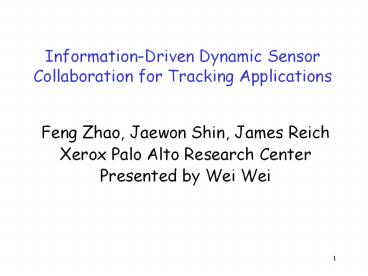Information-Driven Dynamic Sensor Collaboration for Tracking Applications
Title:
Information-Driven Dynamic Sensor Collaboration for Tracking Applications
Description:
Information-Driven Dynamic Sensor Collaboration for Tracking Applications ... Informed selective collaboration of sensors, in contrast to flooding data ... –
Number of Views:28
Avg rating:3.0/5.0
Title: Information-Driven Dynamic Sensor Collaboration for Tracking Applications
1
Information-Driven Dynamic Sensor Collaboration
for Tracking Applications
- Feng Zhao, Jaewon Shin, James Reich
- Xerox Palo Alto Research Center
- Presented by Wei Wei
2
Outline
- Motivation
- Introduction to tracking problem
- Information-driven sensor selection
- Validation
- Representation of belief state
- Conclusion
3
Motivation
- Sensor network is ideally suited for tracking
moving phenomena due to - spatial coverage
- multiplicity in sensing aspect and modality
- Detection, classification and tracking of moving
events requires non-local collaboration among
sensors - Aggregation of multitude of sensor data can
improve accuracy - Informed selective collaboration of sensors, in
contrast to flooding data requests to all
sensors, can reduce latency - Sensor collaboration can minimize bandwidth
consumption (energy savings) and mitigate risk of
network node/link failures - Energy constrained dynamic sensor collaboration
4
Motivation Energy Constrained Dynamic Sensor
Collaboration
- Dynamically determine
- Who should sense
- What needs to be sensed
- Whom the information must be passed on to
- Tracking dynamically invoke regions of a network
informed by motion prediction - Large-scale event monitoring active sensors
around which there has been a significant change
in physical measurement - Disambiguate multiple interpretation of an event
selectively aggregate multiple sources of
information to improve detection accuracy, or to
actively probe certain node
5
Approach
- Base decision for sensor collaboration on
- information constraint
- constraint on cost and resource consumption
- Using measures of information utility, sensors in
a network can exploit information content of data
already received to optimize utility of future
sensing actions, thereby efficiently managing the
scarce communication and processing resources
6
A Tracking Scenario
Report position of the vehicle every 5 seconds
7
Assumptions of Tracking
- No road constraint, no prior knowledge of
possible vehicle trajectories can be exploited - Vehicle can accelerate or decelerate in between
the nearest sensors - Focus on sensing collaboration during the tracing
phase, ignore detection phase, gloss over details
of routing query into region of interest - One leader node is active at any moment. It
selects and routes tracking information to next
leader - Every node knows certain information about their
neighbors location, sensing ability, etc.
8
Leadership Transfer
- Leadership is transferred from node to node
- Leader calculates
- Current belief based on measurements so far
- usefulness of data provided by sensor j
- cost of obtaining information, characterized by
link bandwidth, transmission latency, node
battery power reserve. Cost of handling current
belief state off to sensor j, acquiring data at
sensor j, and combining data with current belief - Based on calculation, select best sensor as next
leader and transfer current belief to next leader
9
Entropy
.11
.11
.11
H(X)2.2
.11
.11
.11
.11
.11
.11
0
0
0
H(X)0
0
0
1
0
0
0
10
Posterior Distribution
.02
.02
.02
.02
.02
.84
.02
.02
.02
?
?
?
?
?
?
?
?
?
?
?
?
?
?
?
?
?
?
11
Posterior Distribution Derivation
12
Expected Entropy, Information Utility and Cost
Function
13
Cost function An Example
14
Validation
15
Validation-cont.
16
Representation of Belief State
Parametric Compact, limited classes of
distributions
Nonparametric When sparse, can be represented
efficiently
Nonparametric Samples
17
Related Work
- Information utility is used in computer vision
and robotics to manage sensing. Sensor selection
is done centrally. Geman96 - Expected utility measures for decentralized
sensing system based on local node.
(communication cost is not explicitly
considered.) Manyika Drrant-Whyte 1994. - Byers 2000 uses a simple step or sigmoid
function to describe utilities of each node,
without explicitly modeling of network spatial
configuration. - This paper consider both spatial configuration
and communication cost.
18
Conclusion
- Formulate distributed tracking problem as an
information optimization problem - Information-driven approach balances information
gain provided by each sensor with cost associated
with acquiring the information - Sensor network can seek to make informed decision
about sensing and communication in energy
constrained environment
19
- Thank you!































